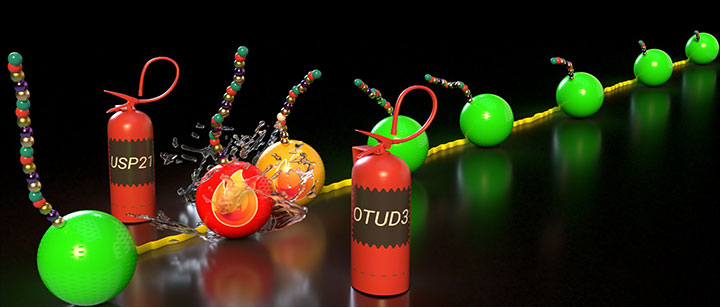Quality Control Mechanisms inside Cells Help Clear Collisions
New model reveals ribosome serves as a unique signaling hub for quality control signals
March 4, 2020
By Mario Aguilera

As ribosomes (green balls) translate an mRNA (yellow string) in a directional manner (background to the foreground), the nascent peptide chain (shiny beads emerging from the green balls) folds into unique functional shapes. Stressors that elicit localized stalls during translation can result in ribosomal collisions (stalled ribosome: red ball; colliding ribosome: orange ball) and trigger ribosomal ubiquitylation. Researchers identified two deubiquitylating enzymes, OTUD3 and USP21 (fire extinguishers), that antagonize ribosomal ubiquitylation, allowing for translation through stall-inducing sequences that would normally terminate translation.
Like an assembly line at a production facility, our cells feature strict quality control measures that ensure products are consistently produced at a high standard.
This applies to messenger RNA, or mRNA, the genetic building blocks that encode the instructions for making proteins— key for normal healthy functioning—as well as the ribosome that decodes the mRNA into proteins.
For many reasons, including damage to mRNA, a ribosome can stop translating a protein before it is fully constructed. These stops in production can cause trailing ribosomes to collide with one that has stalled—a traffic backup that conjures images of the famous “I Love Lucy” chocolate factory conveyor belt episode.
Damaged or incorrectly processed mRNA can lead to the accumulation of deficient aggregation prone protein products that if not removed from the cell can have catastrophic consequences for an organism, including several neurological disorders including Parkinson’s disease and amyotrophic lateral sclerosis (ALS).
Understanding the quality control pathways and the molecular mechanisms involved in maintaining the health of cells is critical to better understanding and identifying potential therapeutic targets for when the system fails.
When ribosomes collide and a backup emerges, the cell must destroy the incomplete protein, the damaged mRNA and recycle the ribosome for reuse. The cellular response that involves the recruitment of numerous molecules to assist in this process is referred to as the “ribosome associated quality control pathway,” or RQC. One aspect of this response mechanism is the attachment of the small molecule ubiquitin to different proteins on the collided ribosomes by molecules known as E3 ligases.
In order for the ribosome to be reutilized for mRNA translation, the ubiquitin must be removed, which is completed by molecules known as deubiquitylating enzymes, or “dubs.”
In a study published in eLife led by UC San Diego graduate student Danielle Garshott, Associate Professor Eric Bennett and their colleagues, the researchers demonstrate that distinct ubiquitylation events on the ribosome encode different functional outcomes. This ribosome-ubiquitin code occurs in a specific order and sets of ubiquitylation events co-occur and are dependent on each other. Identification of this ordered ubiquitylation suggests a new model where the ribosome serves as a unique signaling hub following stress activation of quality control pathways.
Identification of the writers, readers and erasers of this ubiquitin code is important for understanding the physiological consequences associated with an inability to properly establish this ribosomal ubiquitin code in cells and tissues. Garshott and colleagues identified two deubiquitylating enzymes, OTUD3 and USP21, that can reverse ubiquitin modifications on the ribosome. Enhanced or reduced levels of OTUD3 or USP21 impacted the cell’s ability to properly sense ribosome collisions and allowed for read-through of stall-inducing mRNAs.
These findings will allow researchers to understand what happens to ribosomes when collisions fail to be sensed and resolved, and what impact this has on overall cellular health.
Coauthors of the paper include Elayanambi Sundaramoorthy and Marilyn Leonard.
Funding for the study came from the UC San Diego Cell and Molecular Genetics Training Program (T32GM007240), a National Science Foundation Graduate Research Fellowship (DGE-1650112) and the National Institutes of Health (DP2-GM119132 and PGM085764).
